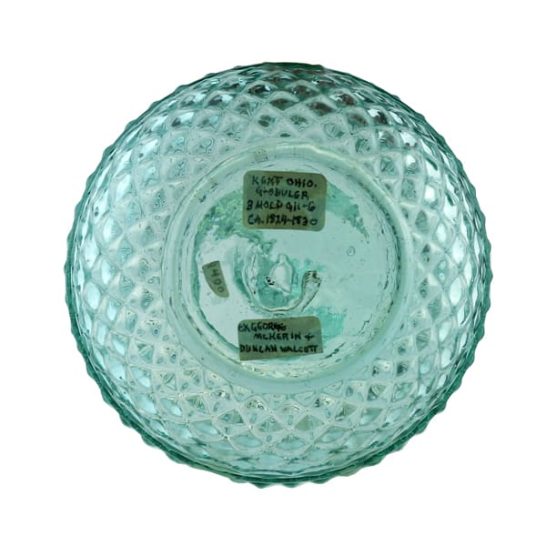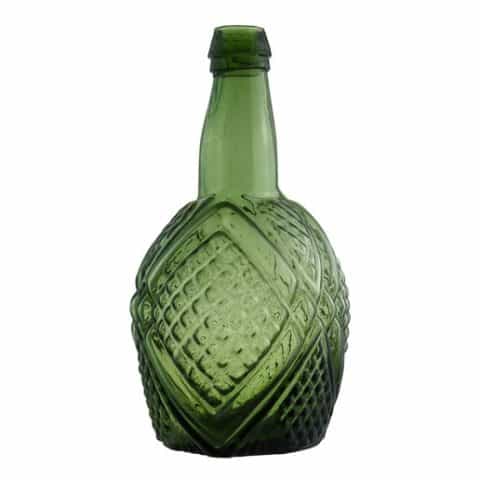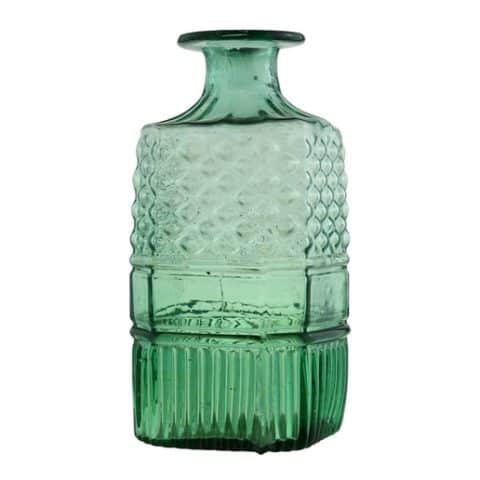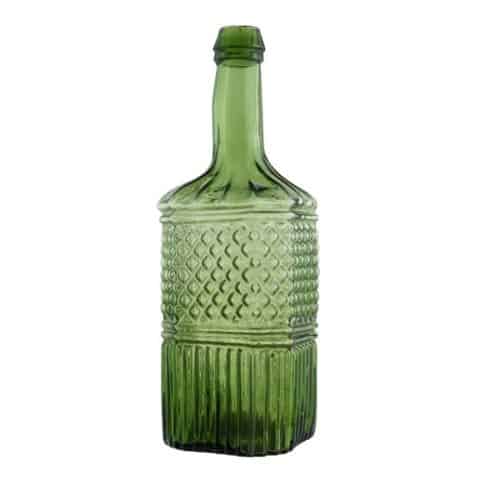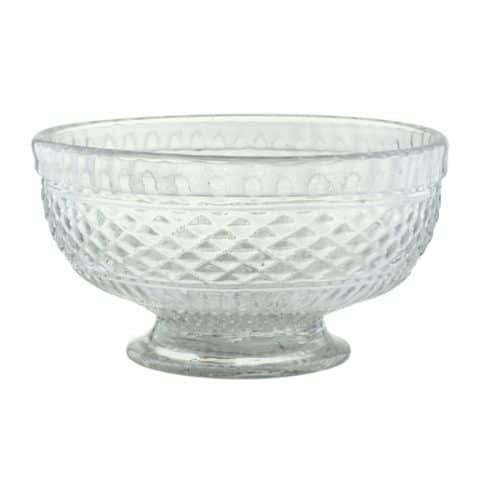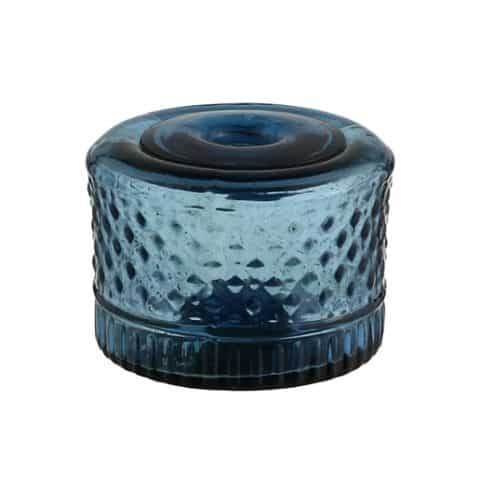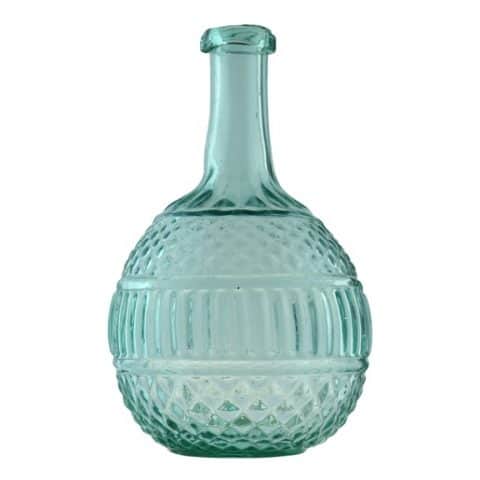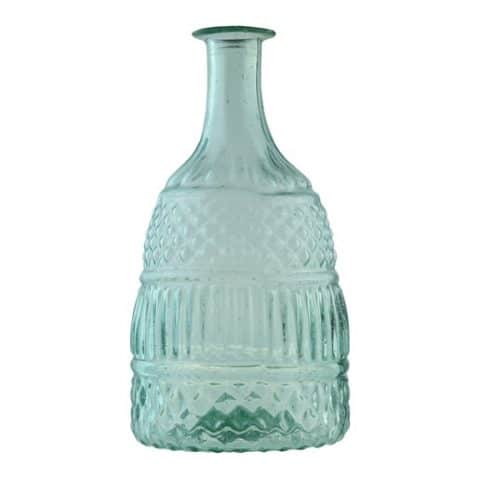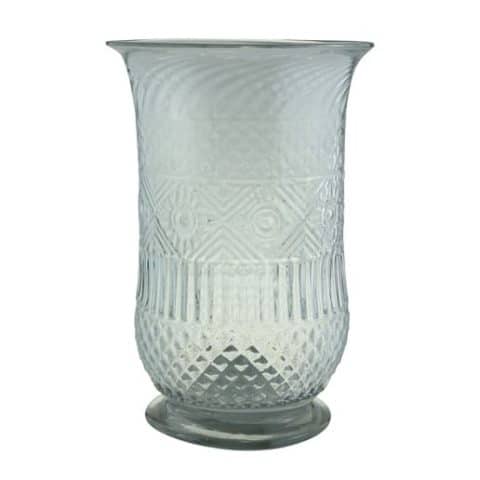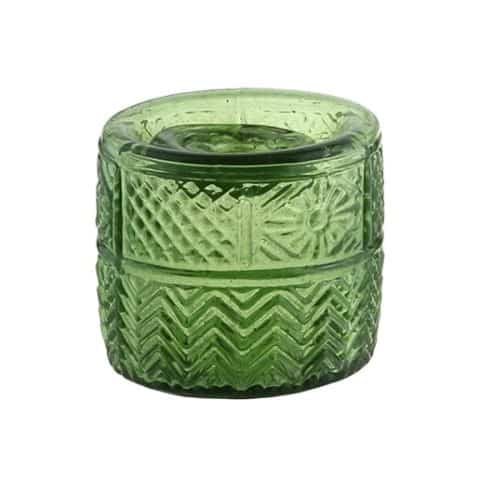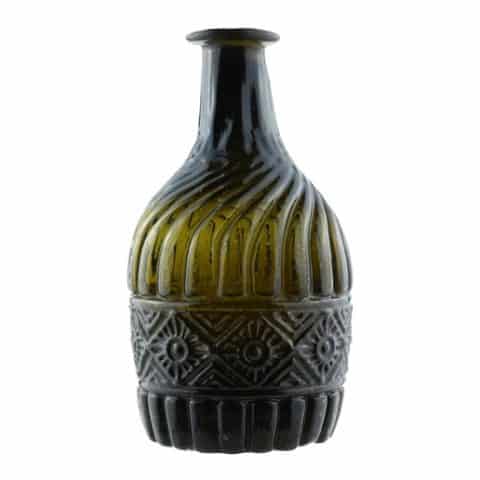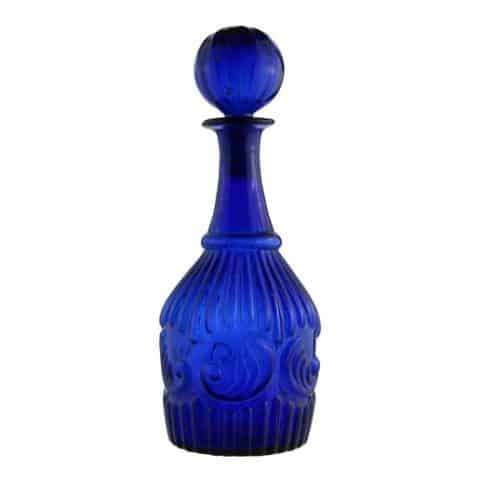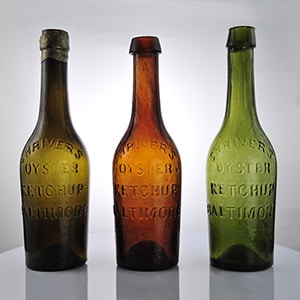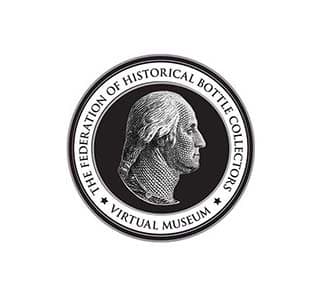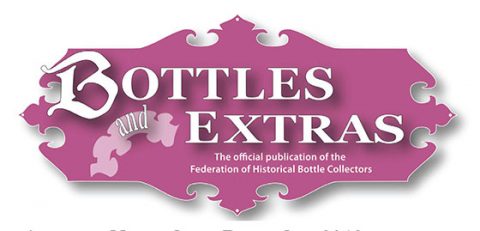GII – 6 Kent Globular Decanter
Blown Three Mold
Kent Globular Decanter
GII – 6
Attributed to Franklin Glass Works, Portage County, Ohio
Aquamarine Geometric Decanter
Provenance: John Fifer Collection, ex Darl Fifer Collection, ex George McKearin collection, ex Duncan B. Wolcott collection
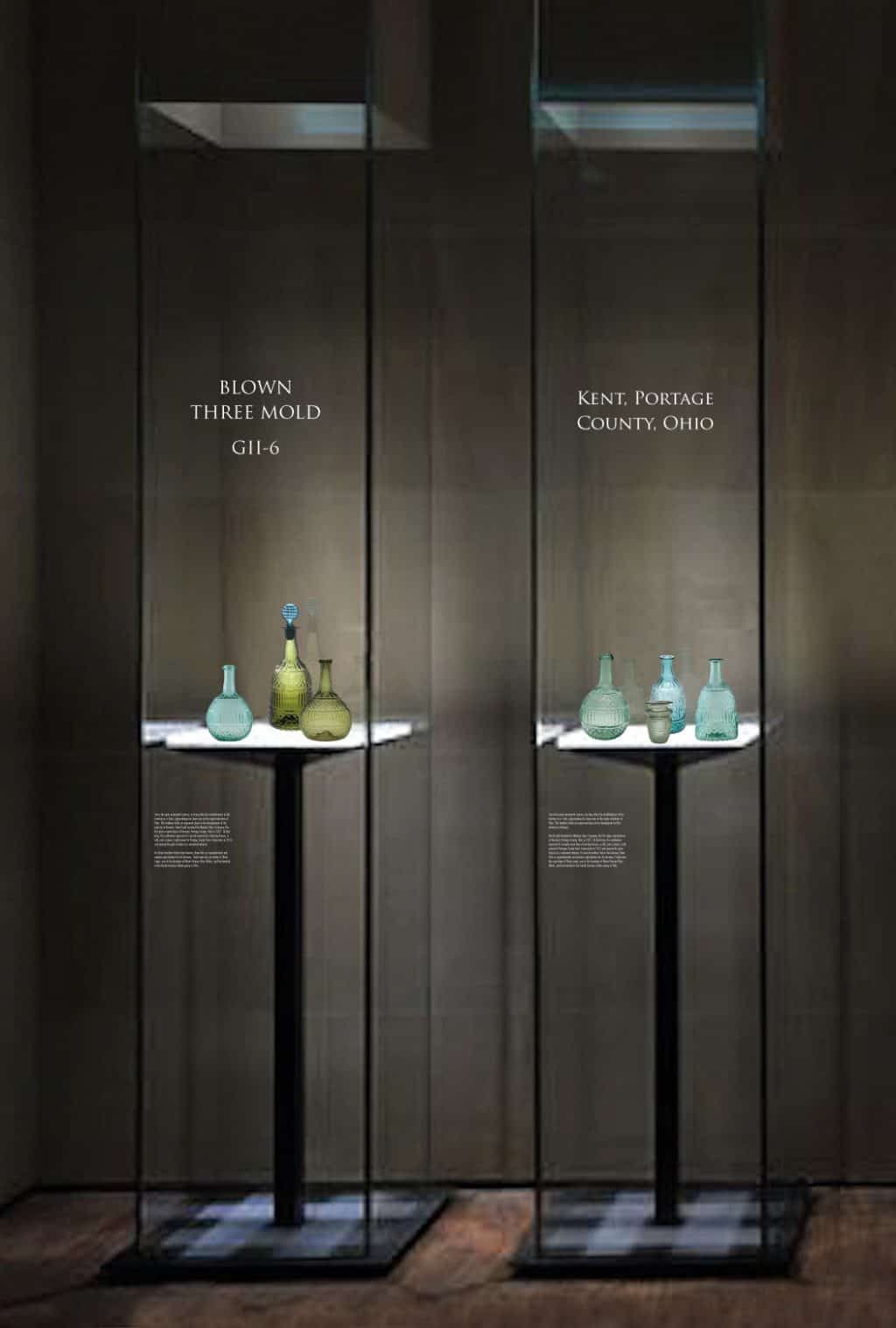
Within the Blown Three Mold Gallery, we present this GII-6 Kent Globular Decanter that was made circa 1824 to 1830 in one of the Kent glass factories in Portage County, Ohio. The provenance is outstanding as it was once in the Darl Fifer, George McKearin, and Dunkin Wolcott collections.
The bright blue, aquamarine globular decanter form is 7 ½” tall, cylindrical with a rounded body with a shoulder showing gadroon ribs. There is a tall gracefully tapering neck finished with a flanged lip. The bottom has a pontil scar. The decanter was formed with a pinch tool creating a circular wafer with verticle ribs between bands of diamond diapering. There are broad horizontal ribs separating the decorative bands.
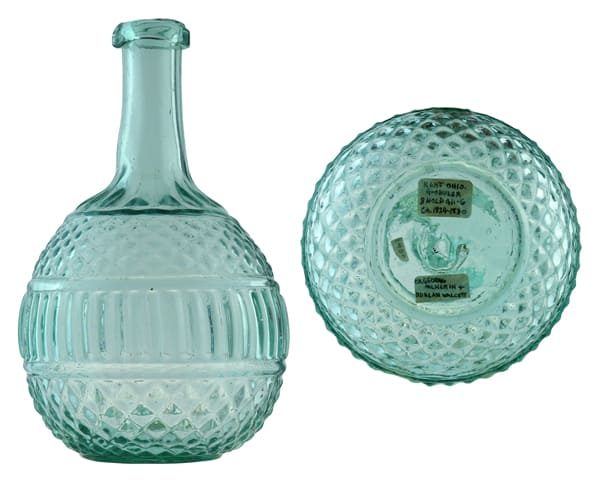
Since the early nineteenth century, not long after the establishment of the territory as a State, glassmaking has been one of the major industries of Ohio, which holds an important place in the development of the glass industry in the United States.
Portage County in the 1820s was sparsely settled though Ohio was granted statehood in 1803. This land was called the Connecticut Western Reserve as it was a portion of land claimed by the Colony of Connecticut and later by the state of Connecticut in what is now mostly the northeastern region of Ohio. The Western Reserve had been granted to the Colony under the terms of its charter by King Charles II. Connecticut relinquished claim to some of its western lands to the United States in 1786 following the American Revolutionary War and preceding the 1787 establishment of the Northwest Territory.
Between 1820 and 1830, the population of Portage Country grew from 8,654 to 18,747 and the number of residents in Franklin Township increased from 348 to 803 in the same period.
Prior to the War of 1812, American-made glass was manufactured east of the Alleghenies, near the population centers with Pittsburgh being the exception. For a number of reasons such as natural resources, western population movement, tax incentives, and cheaper costs compared to similar British glass was the reason for a new type of business in Ohio during this time period – glassmaking. Britain at this time, even with glass tariffs after the War of 1812, could undercut glass prices in America but could not compete with the new glasshouses in the midwest as it cost too much to ship their products over land which was much more expensive than shipping across the Atlantic.
FRANKLIN GLASS WORKS
The site of the Franklin Glass Works was first discovered in 1928 by 1985 FOHBC Hall of Fame recipient Harry Hall White. Mr. White, from Cleveland, Ohio, discussed Kent Glass Works in his papers and published his discoveries in Antiques Magazine in 1934 and 1935. Included in his research was a picture of a field with a barn with two gables in the background. It was during his study of the Franklin Glass Works, that he attributed our subject aquamarine decanters three-mold glass pattern to shards found at the site which was 2-½ miles northwest of Kent, Ohio.
In 1964, Bordon Company executive Duncan B. Wolcott studied White’s papers and started knocking on doors in the area looking for the old glassworks. In 1966, he was joined by Cleveland lawyer James E. Courtney. Wolcott eventually found a barn that closely matched White’s picture. He drove up the driveway to the house on the property and was greeted by Dale E. Hissem. When asked if he ever heard of an old glass factory on his land he said, “It’s back in my cornfield. Every spring when I plow, I turn up hundreds of glass fragments and bricks.” Wolcott followed Hissem to the spot which was “about a half-mile from Seasons Road.” The ground was strewn with broken pieces of glass, bricks, and pieces of broken clay pots.
Wolcott and Courtney obtained a substantial grant from the Kettering Family Foundation to bring scientists to explore the ruins in the late 1960s. The archaeologists worked with tools such as whisk brooms, small paintbrushes, trowels, and screens to dig 18 to 24-inch holes and sometimes deeper. They initially found bits of glass, hardware, pewter buttons, and Indian arrowheads.
Ultimately the excavation revealed several ovens plus the main furnace. Most of the glassware made at the Franklin Glass Works were bottles, flasks, tumblers, and milk pans patterned in dip molds, having a plain or swirled rib design. After the glass was melted in the furnace, it was blown into molds to form bottles, jars, dishes, decanters, flasks, pitchers, pans, bowls, vases, tumblers, scent bottles, and ink bottles. These products were tempered in the cooling ovens of which eight were found on the site.
Five colors of glass were found in abundance on the site – aquamarine, light amber, deep reddish amber, yellow-green, and olive green. Many of the shards were primitive and the colors were not always uniform. The excavation also turned up square nails, charred wood, sandstone, and hundreds of pieces of blue English china which were probably used by the workmen for their meals at the factory.
It is believed that the Franklin Glass Works factory was established in 1824 at a site that was near to all the necessities of glassmaking. Sand or sandstone was there to be melted and mixed with potash and limestone to make glass. A kiln was nearby where bricks for the ovens were made. Clay was available to make the crucibles needed to hold the molten glass and there were plenty of trees to provide wood to fire the furnaces.
An 1825 newspaper advertisement from a Ravenna, Ohio newspaper advertised Franklin Glass-Works being run by Parks, Edmunds & Parks. The Parks brothers, Richard and George, could have been financers and would drop off in 1826 factory advertising that stated James H. Edmunds was running the glass factory. The partnership had lasted only three weeks.
See the museum example a GII-6 Kent Three Mold Decanter
See the museum example of a Kent Pattern Molded Bowl
Though records are scarce, it is believed this era of Franklin Glass Works ended around 1830. There is a belief that there was a devastating fire and other evidence of the main furnace failure. Archaeological excavation of the well at Franklin Glass Works yielded fragments of one of the glory holes, large crucible shards, and large boulders of glass – one of which was so large that it plugged up the well. These components are the resulting debris from a major furnace failure, which may have been the coup de grâce of the glasshouse. If several pots break, or if the furnace collapses – it is often enough to bankrupt a glassworks. There were also some new glasshouses and competition that were quickly gaining popularity for their glass, Mantua and Franklin Mills.
Primary Image: The aquamarine GII-6 Kent Globular Decanter imaged by the FOHBC Virtual Museum midwest studio by Alan DeMaison.
Support Image: Aquamarine GII-6 Kent Blown Three Mold Decanter imaged by the FOHBC Virtual Museum midwest studio by Alan DeMaison.
Support Images: Auction Lot 37: Blown Three Mold Decanter, Parks, Edmunds and Parks, Kent, Ohio, 1824-1834. Cylindrical tapering to shoulder, bright bluish aquamarine, tooled flared mouth – pontil scar, ht. 7 ¼ inches. GII-6. Harry Hall White found evidence that this mold pattern was produced in Kent, Ohio. A rare piece of Midwestern blown three mold glass. Fine condition. – Norman Heckler, Norman C. Heckler & Company, Auction #170
Support Image: Decanter and Stopper. Bottle glass, yellowish olive-green; blown-molded; club-shaped body, long plain neck with narrow flanged lip; geometric pattern (GII-6): band of vertical ribs between bands of diamond diapering, gadroon ribbing at top, wide single horizontal rib between bands, plain base; rough pontil mark. Waffled-disc stopper, clear green. Park, Edmonds & Park, Manufacturer possibly Kent, Ohio, 50.4.172, Overall H: 25.5 cm; Body H: 20.5 cm, Diam (max): 9.25 cm, about 1823-1830 – Corning Museum of Glass
Support Image: Decanter. Bottle glass, bubbly, light yellowish olive-green; blown-molded for pattern; large squat ovoid body, long plain tapering neck with round-collared small mouth; geometric pattern (GII-6): band of vertical ribs between bands of diamond diapering, gadroon ribbing at top, wide single horizontal rib between bands, plain base; rough pontil mark. Park, Edmonds & Park, Manufacturer, possibly Kent, Ohio, 50.4.134, Overall H: 21.3 cm, Diam (max): 14.3 cm, about 1823 – 1830 – Corning Museum of Glass
Support Image: Vase. Transparent light green glass with black impurities; wear marks at base; blown-three-mold; body tapering to slightly concave base with pontil mark, sharp contraction at top to form a wide collar-like bulge, wide flaring rim; patterned in pint decanter mold in pattern GII-6. Probably Kent, Ohio, 55.4.231, Overall H: 13.8 cm; Rim Diam: 9.7 cm; Base Diam: 6 cm, about 1824-1830 – Corning Museum of Glass
Support: Reference to The Franklin Glassworks – The Archaeology of an Early Nineteenth-Century Ohio Industry by David S. Brose with contributions by George Miller, David Frayer, Donna Benson, Melissa Arnold, Dean Zimmerman, and Alfred Lee. Archival Report to the Ohio History Center, Columbus, Ohio. David S. Brose, 2020
Support: Reference to American Bottles and Flasks and Their Ancestry by Helen McKearin and Kenneth M. Wilson, Crown Publishers Inc., New York, 1978.
Support: Reference to Archaeology In a Portage County Cornfield by Charles Buffum, Akron Beacon Journal, November 30, 1869.
Support: Reference to Ohio Glass 1815-1953, The Toledo Museum of Art, October 1953
Support: Reference to History of the Franklin Glass Works, Portage County, Ohio By George L. Miller, Summer 2004, Bottles and Extras
Join the FOHBC: The Virtual Museum is a project of the Federation of Historical Bottle Collectors (FOHBC). To become a member.

